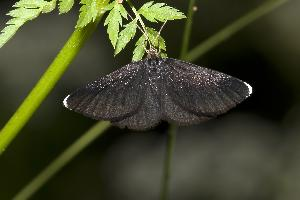
Popis zvířete
The Chimney Sweeper (Odezia atrata) is a captivating species of moth that belongs to the family Erebidae. This small, yet striking, moth is predominantly found across the Palearctic region, stretching from Europe through Siberia to the Russian Far East and Mongolia. It is also present in parts of North America, showcasing its adaptability to various habitats. The Chimney Sweeper's name, intriguingly, is derived from the adult moth's distinct black or dark gray coloration, reminiscent of the soot-covered attire of traditional chimney sweepers.Adults of the Chimney Sweeper moth boast a wingspan ranging from 23 to 27 millimeters. Their forewings are covered in a velvety black or dark gray hue, which serves as excellent camouflage against predators when resting on the bark of trees or among the dark soil. A notable feature of the Chimney Sweeper is a small, white or light-colored spot located on the edge of each forewing, adding a touch of contrast to their otherwise dark appearance. The hindwings are slightly lighter in color, often showing shades of gray or brown, and their bodies are slender and also dark-colored, completing their cryptic look.
One of the most fascinating aspects of the Chimney Sweeper's life cycle is its larval stage. The caterpillars are herbivorous and feed primarily on the leaves of the Pignut (Conopodium majus), a type of flowering plant commonly found in the same habitats as the moth. These caterpillars are green or yellowish-green in color, with a body that is relatively smooth and adorned with fine, sparse hairs. This coloration allows them to blend seamlessly into their surroundings, evading detection from potential predators.
The breeding season of the Chimney Sweeper moth typically occurs in the summer months, from June to August, depending on the geographical location. During this time, the adults emerge and engage in their mating rituals. The females lay their eggs on the underside of the Pignut leaves, ensuring that the emerging caterpillars will have immediate access to food. The larvae feed and grow throughout the summer, and by autumn, they descend into the soil to pupate. They overwinter in this stage, emerging as adults the following year to continue the cycle.
The Chimney Sweeper's habitat preference includes meadows, grasslands, and woodland edges, particularly areas where the Pignut grows abundantly. These environments provide not only the necessary food sources for their larvae but also the ideal conditions for the adult moths to thrive and reproduce. Despite their preference for specific habitats, Chimney Sweepers are considered to be of least concern in terms of conservation status, thanks to their widespread distribution and adaptability to different environments.
In summary, the Chimney Sweeper (Odezia atrata) is a small, yet fascinating moth with a distinctive dark coloration that serves as an effective camouflage against predators. Its life cycle is closely intertwined with the Pignut plant, showcasing a remarkable example of ecological interdependence. Although not endangered, the presence and health of Chimney Sweeper populations can serve as indicators of the health of their preferred meadow and grassland habitats.
Podobná zvířata
Nové fotografie zvířat
Top 10 zvířat
- Dolphin gull (Leucophaeus scoresbii)
- Diana monkey (Cercopithecus diana)
- Moustached guenon (Cercopithecus cephus)
- Galápagos tortoise (Geochelone nigra complex)
- Russian tortoise (Testudo horsfieldii)
- Stone loach (Barbatula barbatula)
- Japanese macaque (Macaca fuscata)
- Greek tortoise (Testudo graeca)
- Common flying dragon (Draco volans)
- Vendace (Coregonus albula)
